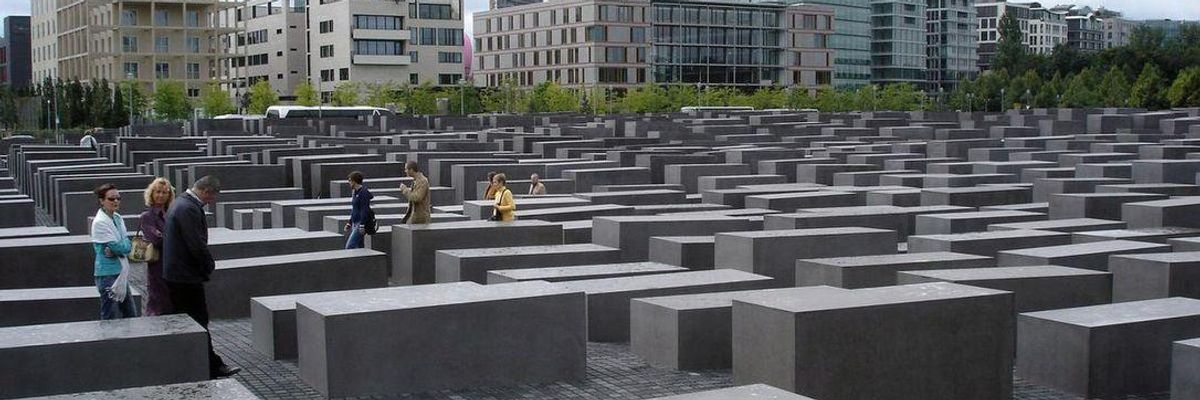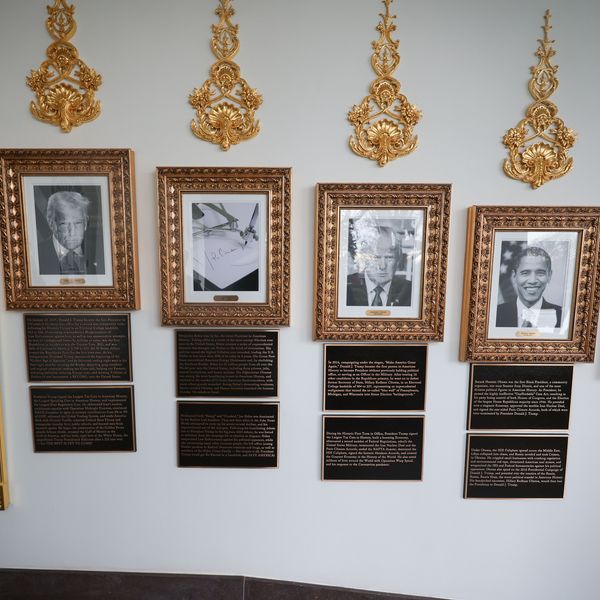
The Memorial to the Murdered Jews of Europe, which rises from the dirt in Berlin, reminds us we are in danger of repeating the past if we allow racism and intolerance to fester, Heather Mallick writes. (Rick Steves / Toronto Star file photo)
Humans Repeat History. Race Wars Are Back
Racism is back in all its forms, locally, nationally and continents-wide
We are breathing violent air. Small groups are being encircled. Tribes are accreting.
Seven hundred words won't do justice to what we face now. So I will describe two pieces of art as memorial that attempt to head off people from repeating the worst of history.
One, at the Alabama lynching museum, hangs over you from above; the other, a Berlin Holocaust monument, rises from the dirt.
The Memorial to the Murdered Jews of Europe in Berlin -- it puzzles me that it wasn't named the Memorial to European Jews Murdered by Germany -- is frightening, as it should be. Designed by U.S. architect Peter Eisenman, it takes the visitor down into a forest of 2,711 dark concrete slabs -- finally brutalism finds its true purpose -- like tombstones. Some are small. Others are tall and lead you among taller ones until you become sliced off from your companions and grow claustrophobic even on a sunny day.
At some points, your face is turned up, looking directly into the sky, and you realize you are surrounded metaphorically by Nazi camp guards. You are hemmed in by being forced to wear a yellow star, unable to work or use public trams, held to curfews, charged money to attempt to leave the country, and finally imprisoned or shot, worked to death, or robbed, shaved, gassed and burned to ash.
On the grass surrounding the memorial, which is near the Brandenburg Gate, people sit and children play, much as Germans did beside Nazi work-to-death camps and death camps.
It's easy to be offended by careless visitors who jump about on the slabs and take selfies -- "everything turns away quite leisurely from the disaster," Auden wrote -- but then you realize that it's a living part of the artwork: those who laughed while it happened, those who didn't care to know.
I don't write about art I haven't experienced, but I'll break the rule for the Legacy Museum's National Memorial for Peace and Justice, which opened this year in Montgomery, Ala., for I choose to visit Alabama precisely never.
The memorial square is terrifying. It comprises 816 steel columns hanging from above, their bases labelled, one for every U.S. county where whites lynched Blacks, and their sides with the names of the victims. As in Berlin, the ground slopes, which means that at first you see the dead slabs at eye level but then, gradually, they come to hang above you.
This puts you in the place of white Southerners, male and female, looking up at their achievement. Above you is a dangling man. Black men were tortured and hanged for the most minor of matters, being near a white woman, "standing around," or failing to call a policeman "mister."
As the New York Times wrote, one name is that of "Mary Turner, who after denouncing her husband's lynching by a rampaging white mob, was hung upside down, burned and then sliced open so that her unborn child fell to the ground."
The memorial, by Mass Design Group, is part of the museum, which is on the site of a slave warehouse halfway between a former slave market and a train/dock station where tens of thousands of slaves were brought in. Again with the trains.
The white Alabama reaction to the memorial has been resentful. And the white supremacists are back, dressed absurdly as ever. Racism is back in all its forms, locally, nationally and continents-wide.
People are repeating history. Not enough people are fighting back or even voting. This time it's different, the white supremacists-misogynists say. No, this time it's the same.
An Urgent Message From Our Co-Founder
Dear Common Dreams reader, The U.S. is on a fast track to authoritarianism like nothing I've ever seen. Meanwhile, corporate news outlets are utterly capitulating to Trump, twisting their coverage to avoid drawing his ire while lining up to stuff cash in his pockets. That's why I believe that Common Dreams is doing the best and most consequential reporting that we've ever done. Our small but mighty team is a progressive reporting powerhouse, covering the news every day that the corporate media never will. Our mission has always been simple: To inform. To inspire. And to ignite change for the common good. Now here's the key piece that I want all our readers to understand: None of this would be possible without your financial support. That's not just some fundraising cliche. It's the absolute and literal truth. We don't accept corporate advertising and never will. We don't have a paywall because we don't think people should be blocked from critical news based on their ability to pay. Everything we do is funded by the donations of readers like you. Will you donate now to help power the nonprofit, independent reporting of Common Dreams? Thank you for being a vital member of our community. Together, we can keep independent journalism alive when it’s needed most. - Craig Brown, Co-founder |
We are breathing violent air. Small groups are being encircled. Tribes are accreting.
Seven hundred words won't do justice to what we face now. So I will describe two pieces of art as memorial that attempt to head off people from repeating the worst of history.
One, at the Alabama lynching museum, hangs over you from above; the other, a Berlin Holocaust monument, rises from the dirt.
The Memorial to the Murdered Jews of Europe in Berlin -- it puzzles me that it wasn't named the Memorial to European Jews Murdered by Germany -- is frightening, as it should be. Designed by U.S. architect Peter Eisenman, it takes the visitor down into a forest of 2,711 dark concrete slabs -- finally brutalism finds its true purpose -- like tombstones. Some are small. Others are tall and lead you among taller ones until you become sliced off from your companions and grow claustrophobic even on a sunny day.
At some points, your face is turned up, looking directly into the sky, and you realize you are surrounded metaphorically by Nazi camp guards. You are hemmed in by being forced to wear a yellow star, unable to work or use public trams, held to curfews, charged money to attempt to leave the country, and finally imprisoned or shot, worked to death, or robbed, shaved, gassed and burned to ash.
On the grass surrounding the memorial, which is near the Brandenburg Gate, people sit and children play, much as Germans did beside Nazi work-to-death camps and death camps.
It's easy to be offended by careless visitors who jump about on the slabs and take selfies -- "everything turns away quite leisurely from the disaster," Auden wrote -- but then you realize that it's a living part of the artwork: those who laughed while it happened, those who didn't care to know.
I don't write about art I haven't experienced, but I'll break the rule for the Legacy Museum's National Memorial for Peace and Justice, which opened this year in Montgomery, Ala., for I choose to visit Alabama precisely never.
The memorial square is terrifying. It comprises 816 steel columns hanging from above, their bases labelled, one for every U.S. county where whites lynched Blacks, and their sides with the names of the victims. As in Berlin, the ground slopes, which means that at first you see the dead slabs at eye level but then, gradually, they come to hang above you.
This puts you in the place of white Southerners, male and female, looking up at their achievement. Above you is a dangling man. Black men were tortured and hanged for the most minor of matters, being near a white woman, "standing around," or failing to call a policeman "mister."
As the New York Times wrote, one name is that of "Mary Turner, who after denouncing her husband's lynching by a rampaging white mob, was hung upside down, burned and then sliced open so that her unborn child fell to the ground."
The memorial, by Mass Design Group, is part of the museum, which is on the site of a slave warehouse halfway between a former slave market and a train/dock station where tens of thousands of slaves were brought in. Again with the trains.
The white Alabama reaction to the memorial has been resentful. And the white supremacists are back, dressed absurdly as ever. Racism is back in all its forms, locally, nationally and continents-wide.
People are repeating history. Not enough people are fighting back or even voting. This time it's different, the white supremacists-misogynists say. No, this time it's the same.
We are breathing violent air. Small groups are being encircled. Tribes are accreting.
Seven hundred words won't do justice to what we face now. So I will describe two pieces of art as memorial that attempt to head off people from repeating the worst of history.
One, at the Alabama lynching museum, hangs over you from above; the other, a Berlin Holocaust monument, rises from the dirt.
The Memorial to the Murdered Jews of Europe in Berlin -- it puzzles me that it wasn't named the Memorial to European Jews Murdered by Germany -- is frightening, as it should be. Designed by U.S. architect Peter Eisenman, it takes the visitor down into a forest of 2,711 dark concrete slabs -- finally brutalism finds its true purpose -- like tombstones. Some are small. Others are tall and lead you among taller ones until you become sliced off from your companions and grow claustrophobic even on a sunny day.
At some points, your face is turned up, looking directly into the sky, and you realize you are surrounded metaphorically by Nazi camp guards. You are hemmed in by being forced to wear a yellow star, unable to work or use public trams, held to curfews, charged money to attempt to leave the country, and finally imprisoned or shot, worked to death, or robbed, shaved, gassed and burned to ash.
On the grass surrounding the memorial, which is near the Brandenburg Gate, people sit and children play, much as Germans did beside Nazi work-to-death camps and death camps.
It's easy to be offended by careless visitors who jump about on the slabs and take selfies -- "everything turns away quite leisurely from the disaster," Auden wrote -- but then you realize that it's a living part of the artwork: those who laughed while it happened, those who didn't care to know.
I don't write about art I haven't experienced, but I'll break the rule for the Legacy Museum's National Memorial for Peace and Justice, which opened this year in Montgomery, Ala., for I choose to visit Alabama precisely never.
The memorial square is terrifying. It comprises 816 steel columns hanging from above, their bases labelled, one for every U.S. county where whites lynched Blacks, and their sides with the names of the victims. As in Berlin, the ground slopes, which means that at first you see the dead slabs at eye level but then, gradually, they come to hang above you.
This puts you in the place of white Southerners, male and female, looking up at their achievement. Above you is a dangling man. Black men were tortured and hanged for the most minor of matters, being near a white woman, "standing around," or failing to call a policeman "mister."
As the New York Times wrote, one name is that of "Mary Turner, who after denouncing her husband's lynching by a rampaging white mob, was hung upside down, burned and then sliced open so that her unborn child fell to the ground."
The memorial, by Mass Design Group, is part of the museum, which is on the site of a slave warehouse halfway between a former slave market and a train/dock station where tens of thousands of slaves were brought in. Again with the trains.
The white Alabama reaction to the memorial has been resentful. And the white supremacists are back, dressed absurdly as ever. Racism is back in all its forms, locally, nationally and continents-wide.
People are repeating history. Not enough people are fighting back or even voting. This time it's different, the white supremacists-misogynists say. No, this time it's the same.

